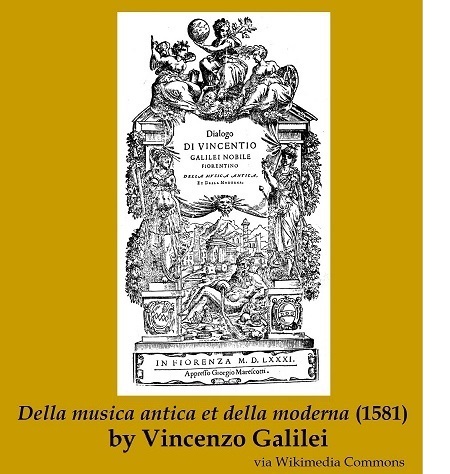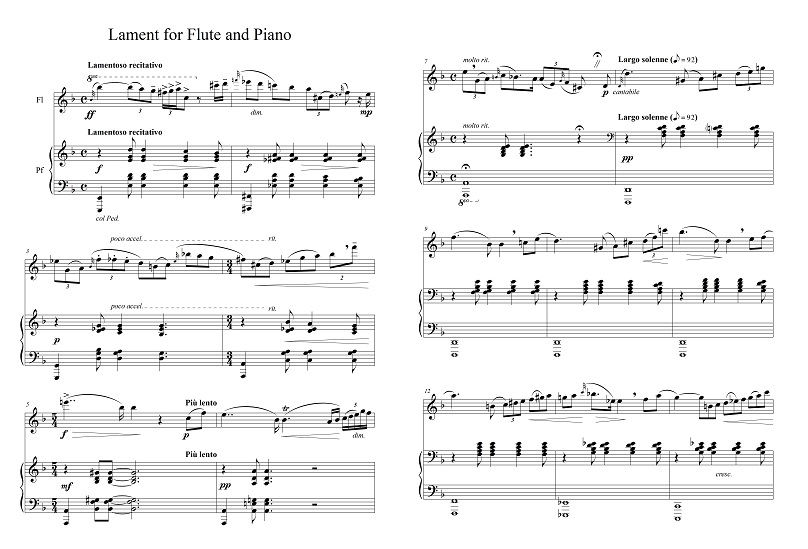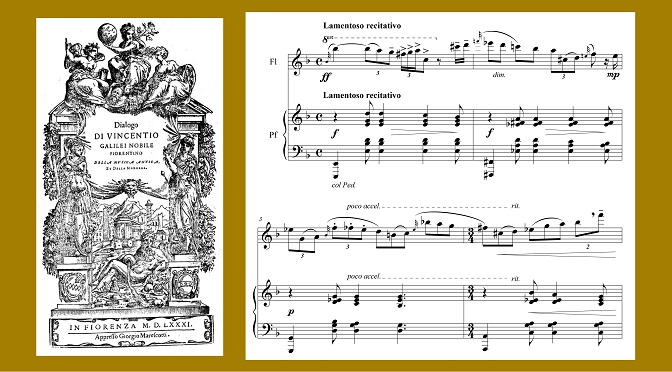Vincenzo Galilei and the Lament
I composed my Lament for Flute and Piano in 1991 but did not attempt to get it performed at the time. In 2016 I got out the old score, dusted it off, and produced a new version in Finale, revising some of the more dissonant and obscure passages to make them more accessible to the listener. The work was more radical than most of my compositions, more experimental in nature, so I had some trepidation as to how it would be received. But when flutist Leslie Lewis and I started performing it for the first time last year, audiences were surprisingly enthusiastic.
The piece has historical roots that go all the way back to the late Renaissance, in sixteenth-century Italy.

Most of us are very familiar with Galileo Galilei, the early astronomer and physicist whom many of us regard as one of history’s true intellectual heroes. Galileo’s father was Vincenzo Galilei (1520-1591), a noted music theorist, composer, and lutenist. He made important contributions to the emerging science of acoustics and is thought to have influenced the young Galileo to appreciate how mathematics could be applied to physical science.
Vincenzo Galilei studied with Gioseffo Zarlino, the foremost music theorist of the Renaissance, but Galilei’s ideas developed in a direction that conflicted with those of his teacher. Where Zarlino’s theories tended toward the abstract and speculative, replete with appeals to Pythagorean numerology, Galilei’s approach was more practical and humanistic, concerned with the emotional meaning of music for human beings. Galilei became an important representative of the Florentine Camerata, a group of musicians, poets, and intellectuals who argued that an overuse of polyphony in the music of the time was undermining its possibilities for dramatic expression. Like many Renaissance thinkers, they looked to antiquity, especially ancient Greece, for their model. Believing that ancient Greek drama had been primarily sung rather than spoken, they sought to develop a new declamatory musical style based on that ideal.
In the new style advocated by Vincenzo Galilei, the focus would be on a single melodic line (“monody”), and dissonance could be treated more liberally than in Renaissance music, in accordance with expressive purposes. For example, the resolution of a dissonance might be embellished by a leap to an intermediate note, leading to more disjunct melodic lines. To illustrate the idea, Galilei composed and performed a setting of Ugolino’s lament from Dante’s Inferno.
While the Camerata’s view of ancient Greek dramatic practice may have been historically inaccurate, their ideas were instrumental in the development a few decades later of a new seconda pratica (or stile moderno) in early Baroque music, used in the new genre of opera and in recitative in particular. In fact, Galilei’s description of the treatment of dissonance accords more with Baroque practice than with the Renaissance practice of his own time. Interestingly, this new approach to dissonance coincided with a movement to tonality as we understand it today and to functional harmony based on tonality. As I pointed out in a previous blog post, tonality and dissonance are not necessarily antagonistic forces; sometimes, in fact, the latter may strengthen the former.
My Lament was inspired by the vibrant style of early Baroque opera and by the vision of the Camerata thinkers from which it sprang.

The first seven bars of the flute part are suggestive of the declamatory style of early Baroque recitative. Dissonance is used freely to enhance the drama, and the highly flexible rhythm, changing meters, and tempo fluctuations emulate expressive speech. The recitative is accompanied by continuo-like chords in the piano part. Although this section is highly dissonant and chromatic, the D minor tonality becomes very clear by the end of the passage, especially by the emphatic half cadence in bar 7. The recitative is followed by a sorrowful aria-like melody in the flute (starting after the fermata in bar 7), again accompanied by continuo-like chords in the piano. Note that the harmonies are relatively modern.
The Lament is not exclusively monodic in style, however, but shows the variety of textures one might expect in a sophisticated early-Baroque composer such as Monteverdi. Counterpoint plays a greater role in the piece’s later passages, where melodies in the flute and piano are interwoven in an expressive duet. Here is the complete work as Leslie and I recorded it on March 25, 2017.

